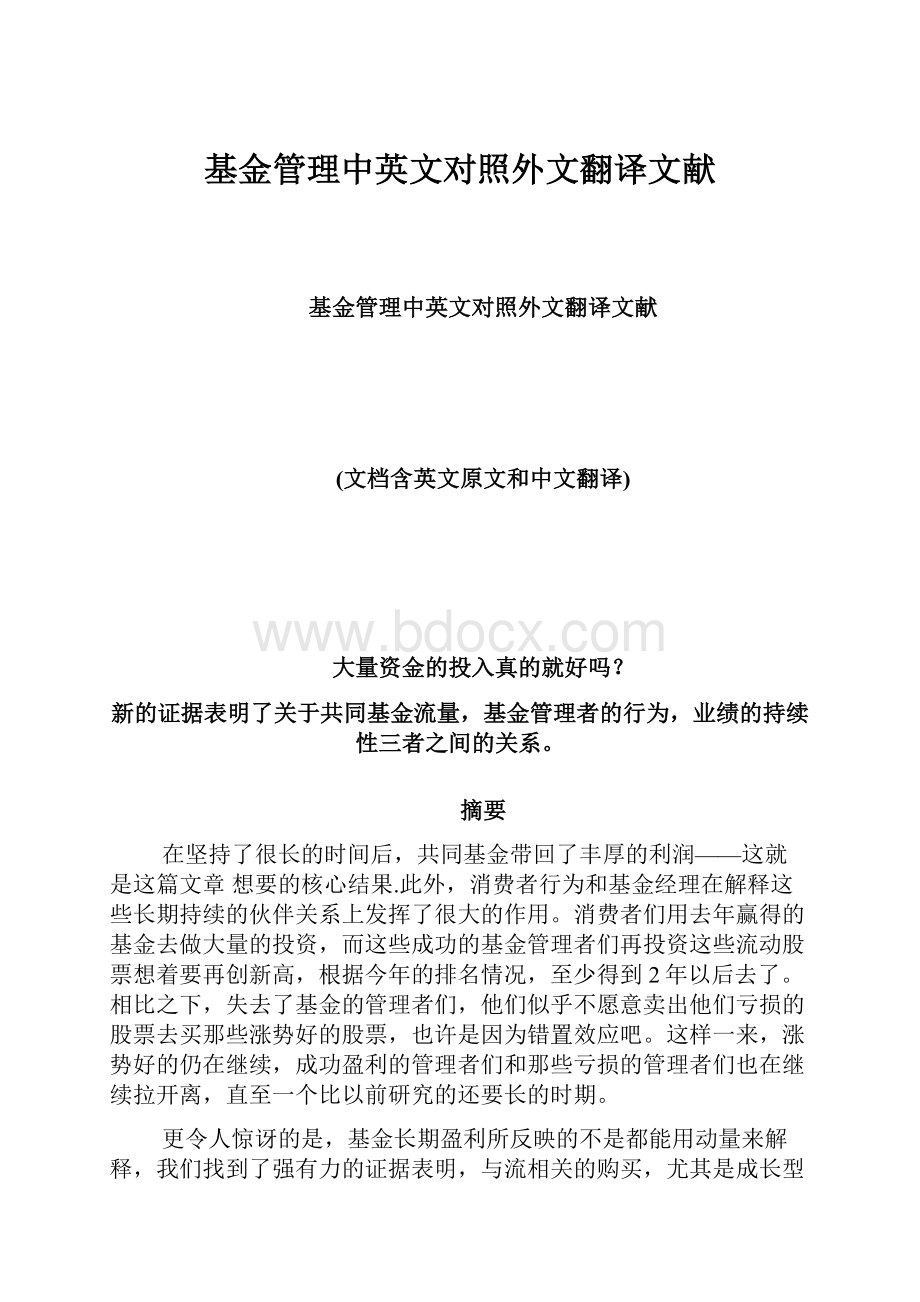基金管理中英文对照外文翻译文献.docx
《基金管理中英文对照外文翻译文献.docx》由会员分享,可在线阅读,更多相关《基金管理中英文对照外文翻译文献.docx(9页珍藏版)》请在冰豆网上搜索。

基金管理中英文对照外文翻译文献
基金管理中英文对照外文翻译文献
(文档含英文原文和中文翻译)
大量资金的投入真的就好吗?
新的证据表明了关于共同基金流量,基金管理者的行为,业绩的持续性三者之间的关系。
摘要
在坚持了很长的时间后,共同基金带回了丰厚的利润——这就是这篇文章想要的核心结果.此外,消费者行为和基金经理在解释这些长期持续的伙伴关系上发挥了很大的作用。
消费者们用去年赢得的基金去做大量的投资,而这些成功的基金管理者们再投资这些流动股票想着要再创新高,根据今年的排名情况,至少得到2年以后去了。
相比之下,失去了基金的管理者们,他们似乎不愿意卖出他们亏损的股票去买那些涨势好的股票,也许是因为错置效应吧。
这样一来,涨势好的仍在继续,成功盈利的管理者们和那些亏损的管理者们也在继续拉开离,直至一个比以前研究的还要长的时期。
更令人惊讶的是,基金长期盈利所反映的不是都能用动量来解释,我们找到了强有力的证据表明,与流相关的购买,尤其是成长型基金,推动了股票的价格。
特别的是,用赢回的基金拿去购买的响应着持续性流动性的股票已经撼动了他们的大小,市场和一个为期四年的每年百分之二到百分之三的动量基准。
根据横截面分析表明,这些异常的回报与资金的流入密切相关,但却不是因为过去段时间资金的表现,因此,对于研究表明的长期坚持的经理人在选择股票上是有才能的。
最后,在风格调整后的净收益水平,我们并没有发现他的持久性,与以往的研究结果一致。
总的来说,在成功的经理人的带领下的巨富是非常明智的,但是用跟风模仿策略来赢得股票基金与流相关的回报来交易似乎是最明智的策略。
八百零八万人现在在美国持有投资的共同基金,同那些超过百分之九十的这些投资基金的价值被作为活动管理资金。
此外,积极管理的股票基金获得了如预算所言的消费者流入量-新资金的净流入量在2000年的时候为309000000000美元,这些资金所持有的能推动资金的总价值在2000年底将近4亿美元。
虽然,大多数的个人投资者是充分相信那些活跃投资者的职业道德的,一般来说,很多人对那些具有投资天赋的人具有偏执的信任,他们更愿意相信,在管理者们的活动领域,更高级的经济管理人的存在能够长时间的占领市场。
特别是,晨星和理铂的的激烈竞争正在靠提供定期基金排名来积极争取他们的客户,然而像金钱杂志封面上的共同基金经理人也成为了一种潮流。
此外,投资美元的人并没有很快放弃之前亏损的基金转而去疯狂的去追逐那些成功的基金管理人。
这些性质是在浪费他们的金钱和时间还是这些金主们真的很聪明呢?
在过去有很多的论文试图解决这些问题,然后产生了各种各样的结果。
比如说,GrinblattandTitman发现部分的基金经理能够始终如一的正常收入和支出,而像他们俩这样的就只能在基金异常的时候出现负收入。
Gruber和郑先生坚持从消费者的视角来检查其投资在基金中的资金流向,然后发现这些投资者真的是非常的明智-那就是,资金流的不成比例现象造成了未来的巨大收益。
然而,这些投资效果甚好的钱的来源仍然是一个谜,这些明智的投资基金真的能够胜任那些能干的基金经理吗,还是仅仅只是基金收益的猛烈势头。
最近,Carhar一直在坚持监测着共有基金的投资回报,目的就是为了维持价格的平衡。
与之一起的人有FamaandFrenchJegadeeshandTitman(1993),DanielandTitman(1997),andMoskowitzandGrinblatt(1999)).
卡哈尔发现了一点,更高级的资金的一直走在他们基准风格的前面,卡尔发现基金的最高回报率在一年当中的最低收入也达到了总基金量的百分之3.5.在接下来的一年当中,几乎所有的整个年所记录的的动量效应由SappandTiwari发现,在净收益的水平上,金钱效应是由基金动量来显示的而不是由于基金管理者的才能实现。
因此,Teo和Woo发现了一个“傻钱效应”,那就是在很多年当中,高流入资金的的运作比低资金的运作要差。
这样一来,Carhart就认为钱多并不是很明智。
而且最近的一些报道也是说找到了比卡尔更有说服力的结果。
Chen,Jegadeesh,andWermers也发现了,那些被基金积极购买的股票打击到了那些每年卖掉百分之二的活跃分子,而Bollen和Busse也发现了关于基金季度性的持久性表现证据。
IsMoneyReally“Smart”?
NewEvidenceontheRelationBetweenMutualFundFlows,ManagerBehavior,andPerformancePersistence.
RussWermers*
DepartmentofFinance
RobertH.SmithSchoolofBusiness
UniversityofMaryland
CollegePark,MD20742-1815
(301)405-0572
November2003
*
Abstract
Mutualfundreturnsstronglypersistovermulti-yearperiods—thatisthecentralfindingofthispaper.Further,consumerandfundmanagerbehaviorbothplayalargeroleinexplainingtheselong-termcontinuationpatterns—consumersinvestHeavilyinlast-year’swinningfunds,andmanagersofthesewinnersinvesttheseinflowsinmomentumstockstocontinuetooutperformotherfundsforatleasttwoyearsfollowingtherankingyear.Bycontrast,managersoflosingfundsappearreluctanttoselltheirlosingstockstofinancethepurchaseofnewmomentumstocks,perhapsduetoadispositioneffect.Thus,momentumcontinuestoseparatewinningfromlosingmanagersforamuchlongerperiodthanindicatedbypriorstudies.
Evenmoresurprisingisthatpersistenceinwinningfundreturnsisnotentirelyexplainedbymomentum—wefindstrongevidencethatflow-relatedbuying,especiallyamonggrowth-orientedfunds,pushesupstockprices.Specifically,stocksthatwinningfundspurchaseinresponsetopersistentflowshavereturnsthatbeattheirsize,book-to-market,andmomentumbenchmarksbytwotothreepercentperyearoverafour-yearperiod.Cross-sectionalregressionsindicatethattheseabnormalreturnsarestronglyrelatedtofundinflows,butnottothepastperformanceofthefunds—thus,castingsomedoubtonpriorfindingsofpersistentmanagertalentinpickingstocks.Finally,atthestyle-adjustednetreturnslevel,wefindnopersistence,consistentwiththeresultsofpriorstudies.Onbalance,weconfirmthatmoneyissmartinchasingwinningmanagers,butthata“copycat”strategyofmimickingwinningfundstocktradestotakeadvantageofflow-relatedreturnsappearstobethesmarteststrategy.
Eighty-eightmillionindividualsnowholdinvestmentsinU.S.mutualfunds,withover90percentofthevalueoftheseinvestmentsbeingheldinactivelymanagedfunds.Further,activelymanagedequityfundsgainthelion’sshareofconsumerinflows—flowsofnetnewmoneytoequityfunds(inflowsminusoutflows)totalled$309billionin2000,pushingtheaggregatevalueofinvestmentsheldbythesefundstoalmost$4trillionatyear-end2000.
Whilethemajorityofindividualinvestorsapparentlybelieveinthevirtuesofactivemanagement
ingeneral,manyappeartoholdevenstrongerbeliefsconcerningthetalentsofsubgroupsoffundmanagers—theyappeartobelievethat,amongthefieldofactivemanagers,superiormanagersexistthatcan“beatthemarket”forlongperiodsoftime.Inparticular,MorningstarandLippercompetevigorouslyfortheattentionofthesetruebelieversbyprovidingregularfundperformancerankings,whilepopularpublicationssuchasMoneyMagazineroutinelyprofile“star”mutualfundmanagers.Inaddition,investordollars,whilenotveryquicktoabandonpastlosingfunds,aggressivelychasepastwinners(see,forexample,SirriandTufano(1998)).
Arethese“performance-chasers”wastingtheirmoneyandtime,orismoney“smart”?
Severalpastpapershaveattemptedtotacklethisissue,withsomewhatdifferingresults.Forexample,GrinblattandTitman(1989a,1993)findthatsomemutualfundmanagersareabletoconsistently
earnpositiveabnormalreturnsbeforefeesandexpenses,whileBrownandGoetzmann(1995;BG)attributepersistencetoinferiorfundsconsistentlyearningnegativeabnormalreturns.Gruber(1996)andZheng(1999)examinepersistencefromtheviewpointofconsumermoneyflowstofunds,andfindthatmoneyis“smart”—thatis,moneyflowsdisproportionatelytofundsexhibitingsuperiorfuturereturns.However,theexactsourceofthesmartmoneyeffectremainsapuzzle—doessmartmoneycapturemanagertalentor,perhaps,simplymomentuminstockreturns?
Morerecently,Carhart(1997)examinesthepersistenceinnetreturnsofU.S.mutualfunds,controllingforthecontinuationattributabletopricedequitystyles(see,forexample,Famaand
French(1992,1993,1996),JegadeeshandTitman(1993),DanielandTitman(1997),andMoskowitzandGrinblatt(1999)).Carhartfindslittleevidenceofsuperiorfundsthatconsistentlyoutperformtheirstylebenchmarks—specifically,Carhartfindsthatfundsinthehighestnetreturndecile(oftheCRSPmutualfunddatabase)duringoneyearbeatfundsinthelowestdecilebyabout3.5percentduringthefollowingyear,almostallduetotheone-yearmomentumeffectdocumented1SappandTiwari(2002)findevidencethat,atthenetreturnlevel,thesmart-moneyeffectcanbeexplainedbymomentumandnotbymanagertalent,whileTeoandWoo(2001)findevidenceofa“dumbmoney”effect—thatis,highinflowfundsunderperformlowinflowfundsovermulti-yeartimeperiods.1byJegadeeshandTitman(1993)andtotheunexplainedpoorperformanceoffundsinthelowestprior-yearreturndecile.Thus,Carhart(1997)suggeststhatmoneyisnotverysmart.
RecentstudiesfindsomewhatmorepromisingresultsthanCarhart(1997).Chen,Jegadeesh,andWermers(1999)findthatstocksmostactivelypurchasedbyfundsbeatthosemostactivelysoldbyovertwopercentperyear,whileBollenandBusse(2002)findevidenceofpersistenceinquarterlyfundperformance.
Bibliography
[1]Badrinath,S.G.,andSunilWahal,2002,“MomentumTradingbyInstitutions,”JournalofFinance,57,pp.2449-2477.
[2]Berk,JonathanB.,andRichardC.Green,“MutualFundFlowsandPerformanceinRationalMarkets,”WorkingPaper.
[3]Bollen,NicolasandJeffreyBusse,2002,“Short-TermPersistenceinMutualFundPerformance,”
WorkingPaper.
[4]Brown,StephenJ.andWilliamN.Goetzmann,1995,“PerformancePersistence,”JournalofFinance,50,pp.679-698.
[5]Brown,StephenJ.,WilliamN.Goetzmann,RogerG.Ibbotson,andStephenA.Ross,1992,“SurvivorshipBiasinPerformanceStudies,”ReviewofFinancialStudies,5,pp.553-580.
[6]Carhart,Mark,1997,“OnPersistenceinMutualFundPerformance,”JournalofFinance,52,pp.57-82.
[7]Chen,Hsiu-Lang,NarasimhanJegadeesh,andRussWermers,1999,“TheValueofActiveMutualFundManagement:
AnExaminationoftheStockholdingsandTradesofFundManagers,”JournalofFinancialandQuantitativeAnalysis,forthcoming.
[8]Clements,Jonathan,2001,“ResistingtheLureofManagedFunds,”WallStreetJournal,February27,pageC1.
[9]Cohen,RandolphB.andChristopherK.Polk,1998,“TheImpactofIndustryFactorsinAsset-PricingTests,”WorkingPaper.
[10]Daniel,Kent,MarkGrinblatt,SheridanTitman,andRussWermers,1997,“MeasuringMutualFundPerformancewithCharacteristic-BasedBenchmarks,”JournalofFinance,52,pp.1035-1058.
[11]Daniel,KentandSheridanTitman,1997,“EvidenceontheCharacteristicsofCross-SectionalVariationinCommonStockReturns,”JournalofFinance,52,pp.1-33.
[12]Edelen,Roger,1999,“InvestorFlowsandtheAssessedPerformanceofOpen-EndMutualFunds,”JournalofFinancialEconomics,53,pp.439-466.
[13]Fama,EugeneF.andKennethR.French,1992,“TheCross-SectionofExpectedStockReturns,”JournalofFinance,47,pp.427-465.
[14]Fama,EugeneF.andKennethR.French,1993,“CommonRiskFactorsintheReturnsonStocksAndBonds,”JournalofFinancialEconomics,33,pp.3-56.
[15]Fama,EugeneF.andKennethR.French,1996,“MultifactorExplanationsofAssetPricingAnomalies,”JournalofFinance,51,pp.55-84.
[16]Fama,EugeneF.andJamesD.MacBeth,1973,“Risk,Return,andEquilibrium:
EmpiricalTests,”JournalofPoliticalEconomy,81,pp.607-636.
[17]Ferson,WayneE.andKennethKhang,2000,“ConditionalPerformanceMeasurementUsingPortfolioWeights:
EvidenceforPensionFunds,”WorkingPaper.
[18]Ferson,WayneE.andRudiW.Schadt,1996,“MeasuringFundStrategyAndPerformance